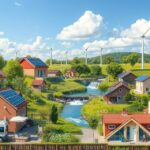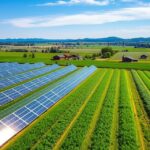An average American home can cut electricity bills by 50% using solar energy. You don’t need advanced skills or big investments to build an affordable solar project. This guide will help you create a DIY solar panel for under $100.
Solar tech is now more accessible for homeowners seeking eco-friendly energy options. With basic tools and know-how, you can make a solar panel that saves money and helps the environment.
Our tutorial breaks down solar panel creation into easy steps. This guide is perfect for renewable energy fans and budget-conscious homeowners alike.
We’ll cover solar energy basics, material selection, and panel assembly. You’ll learn all you need to start your own solar energy project.
Get ready to change how you produce energy at home. This practical, cost-effective solution is within your reach.

Understanding the Basics of Solar Energy
Solar energy is a powerful renewable DIY solution for homeowners. It transforms sunlight into electricity for homes and businesses. This clean power source uses the sun’s abundant radiation.
To use solar power at home, you need to understand how it works. Let’s explore the key concepts of this amazing technology.
What is Solar Energy?
Solar energy comes from the sun’s light and heat. It’s captured and turned into usable electrical power. Photovoltaic cells in solar panels change sunlight into electricity.
- Captures renewable energy from sunlight
- Converts solar radiation into electrical power
- Provides a sustainable alternative to fossil fuels
Benefits of Using Solar Energy
Using solar power at home has many perks:
- Reduces electricity bills
- Decreases carbon footprint
- Increases property value
- Provides energy independence
“Solar energy is not just a technology, it’s a pathway to a sustainable future.” – Clean Energy Expert
Solar Panel Efficiency Explained
Solar panel efficiency shows how much sunlight becomes electrical energy. Today’s panels usually range from 15% to 22% efficiency. New DIY technologies keep improving these numbers.
| Panel Type | Efficiency Range | Cost |
|---|---|---|
| Monocrystalline | 17-22% | Higher |
| Polycrystalline | 15-17% | Moderate |
| Thin-Film | 10-15% | Lower |
Understanding these basics helps homeowners make informed decisions about implementing solar energy solutions.
Materials Needed for DIY Solar Panels
Creating affordable solar panels requires careful planning and the right materials. With the proper components and tools, you can build a DIY solar energy solution. This can power small electronics or outdoor spaces effectively.
Essential Components for Your Solar Panel
Choosing the right materials is key for your solar panel project. Here are the main components you’ll need:
- Photovoltaic solar cells
- Tabbing wire
- Bus wire
- Tempered glass
- EVA film (encapsulation material)
- Backing sheet
- Frame materials
Tools Required for Assembly
Having the right tools will make your solar panel project smoother and more efficient. Here’s what you’ll need:
- Soldering iron
- Multimeter
- Wire cutters
- Flux pen
- Protective silicone adhesive
Safety Gear and Precautions
Safety should be your top priority when working on solar panel projects. Use proper gear and take necessary precautions.
| Safety Item | Purpose |
|---|---|
| Safety glasses | Protect eyes from soldering sparks |
| Protective gloves | Prevent burns and chemical exposure |
| Ventilated workspace | Minimize exposure to soldering fumes |
“Preparation is the key to a successful and safe DIY solar panel project.” – Solar Energy Enthusiast
Pro tip: Always purchase high-quality materials from reputable suppliers to ensure the best performance and longevity of your affordable solar panel.
Designing Your Solar Panel Layout
Planning is key for an effective DIY solar panel. The layout impacts energy generation and performance. A well-designed guide helps optimize your renewable energy project.
Understanding key factors sets you up for success. These factors affect the panel’s efficiency and power output.
Choosing the Right Dimensions
Several factors influence solar panel dimensions. These include available space, energy needs, budget, and power goals.
- Available space for installation
- Energy consumption requirements
- Budget constraints
- Intended power generation goals
Positioning the Solar Cells
Proper cell placement maximizes energy capture. Follow these positioning guidelines:
- Ensure maximum sun exposure
- Minimize shading from surrounding objects
- Maintain proper angle for optimal energy absorption
Understanding Wire Configurations
Wire setups affect your DIY solar panel’s performance. Different wiring methods yield varied results:
| Configuration | Voltage Output | Current Capacity |
|---|---|---|
| Series Connection | Higher Voltage | Same Current |
| Parallel Connection | Same Voltage | Higher Current |
“Precise solar panel design transforms amateur projects into professional-grade renewable energy solutions.”
Mastering these design principles helps create an efficient solar panel. It ensures your DIY project meets your energy needs.
Careful planning leads to optimal performance and long-term reliability. Your solar panel will deliver the results you seek.
Assembling the DIY Solar Panel
Building your own solar panel is an exciting renewable energy project. With the right approach, you can create an efficient panel for your home. Let’s explore how to assemble your DIY solar panel step by step.
Precision is key in solar panel construction. Organize all your materials and tools before starting. This preparation ensures a smooth assembly process.
Critical Assembly Preparation
- Clean your workspace thoroughly
- Arrange solar cells on a flat, stable surface
- Check all components for damage
- Verify electrical connections are intact
Soldering Solar Cells
Soldering is vital in connecting solar cells. Use a low-wattage iron and apply gentle, consistent pressure. Gentle, consistent pressure helps create strong electrical connections without damaging delicate cells.
“Precision matters more than speed when assembling solar panels.” – Solar Energy Expert
Common Assembly Mistakes to Avoid
- Applying too much heat during soldering
- Misaligning solar cells
- Skipping protective coating
- Neglecting electrical continuity checks
Efficient Assembly Tips
Work systematically to streamline your project. Practice soldering on spare cells first. Use flux for better connections and wear protective eyewear.
Take breaks to prevent fatigue. A steady hand is crucial for precise assembly.
Final Panel Configuration
Arrange solar cells in a consistent pattern. Minimize gaps and maximize surface coverage. A well-designed layout boosts your panel’s energy generation potential.
Connecting Your Solar Panel to a Battery
Careful battery selection is crucial for an effective solar power system. Your DIY solar panel’s performance relies on proper energy storage and management. Understanding battery integration is essential for maximizing your renewable energy setup.
Choosing the Right Battery Type
Consider these factors when selecting a battery for your DIY solar panel:
- Lead-acid batteries: Budget-friendly option
- Lithium-ion batteries: Higher efficiency and longer lifespan
- Gel batteries: Maintenance-free alternative
“The right battery can make or break your solar power system for home performance.” – Solar Energy Experts
Step-by-Step Connection Guide
Connect your DIY solar panel to a battery safely and precisely:
- Verify voltage compatibility
- Use appropriate connection cables
- Install a charge controller
- Check polarity before connecting
Managing Battery Storage
Proper battery storage ensures optimal performance and longevity of your solar energy system. Keep batteries in cool, dry environments and check charge levels often.
Smart charging practices can significantly extend your battery’s useful life.
Pro tip: Always wear protective gear when handling batteries and follow manufacturer guidelines for your specific DIY solar panel setup.
Testing Your DIY Solar Panel
Testing is vital for your DIY solar panel’s optimal performance. Checking voltage output and finding issues helps maximize your installation guide’s effectiveness.
Proper testing ensures your solar energy project works well. It verifies the panel’s output and identifies potential problems.

How to Measure Voltage Output
Use a digital multimeter to measure your solar panel’s voltage output. Here’s how to do it:
- Set the multimeter to DC voltage mode
- Connect red probe to positive terminal
- Connect black probe to negative terminal
- Record the voltage reading in direct sunlight
“Accurate voltage measurement is the key to understanding your solar panel’s performance.” – Solar Energy Expert
Troubleshooting Common Issues
You might face challenges while testing your solar energy project. Here are some common issues:
- Low voltage output: Check for loose connections
- Inspect solar cells for damage
- Verify proper wiring configuration
- Clean solar panel surface
Ensuring Safety During Testing
Safety is crucial when testing your DIY solar panel. Wear protective gear and work in a well-ventilated area.
Avoid testing in wet conditions. Use insulated tools and disconnect the panel from any battery system before measuring.
Follow these guidelines to validate your solar panel’s performance safely. You’ll create a secure working environment while checking your panel’s effectiveness.
Installing Your Solar Panel System
A successful solar power system needs careful planning and precise installation. Your DIY project reaches a critical stage when setting up the final system. Proper installation ensures long-term efficiency and performance.
Best Locations for Solar Panel Installation
Choosing the right location maximizes your solar panel’s energy production. The ideal site should meet several key criteria.
- Direct sunlight exposure for most of the day
- Minimal shade from trees or buildings
- Unobstructed southern-facing surface (in the Northern Hemisphere)
- Sturdy and level mounting area
Mounting Techniques for Stability
Strong mounting keeps your solar panels effective in various weather conditions. Consider these options:
| Mounting Type | Best Use | Stability Rating |
|---|---|---|
| Roof Mount | Residential homes | High |
| Ground Mount | Large property areas | Very High |
| Pole Mount | Open landscapes | Medium |
Weatherproofing Your Setup
Protecting your solar power system against environmental challenges is crucial. Use these weatherproofing strategies:
- Apply waterproof sealants around mounting points
- Install protective covers during extreme weather
- Use corrosion-resistant mounting hardware
- Ensure proper drainage around panel installations
“A well-installed solar panel system can last 25-30 years with proper maintenance and protection.” – Solar Energy Experts
Remember that each installation is unique, and local climate conditions will influence your specific approach to mounting and protecting your solar panels.
Expanding Your Solar Energy Project
Upgrading your renewable energy DIY project requires smart planning. Solar panel project ideas can boost your energy system’s power. These upgrades can meet your growing energy needs effectively.
Expanding your solar system needs careful thought on setup and parts. The right approach can boost energy output while keeping costs down. It’s crucial to balance power increase with budget constraints.
Adding More Panels for Increased Power
Boosting solar energy capacity means adding panels wisely. Here are key strategies to consider:
- Assess current energy consumption patterns
- Evaluate available installation space
- Calculate potential power generation improvements
Series vs. Parallel Configurations
Your choice between series and parallel setups affects system performance. Each option has its benefits:
| Configuration | Voltage Output | Current Capacity | Best Use |
|---|---|---|---|
| Series | Increased | Unchanged | Higher voltage applications |
| Parallel | Unchanged | Increased | Higher current requirements |
Upgrading Components for Performance
Improve your solar DIY project by focusing on key upgrades:
- Invest in high-efficiency solar cells
- Upgrade charge controllers
- Select advanced battery storage systems
“The future of renewable energy lies in continuous innovation and strategic system improvements.” – Solar Energy Experts
Smart expansion turns your solar project into a powerful, adaptable energy solution. It can grow with your changing power needs over time.
Costs and Budgeting for Solar Projects
DIY solar panel projects need careful financial planning. Exploring affordable options can help create efficient energy solutions. Smart budgeting makes solar energy accessible and realistic.
Understanding cost components is key to successful DIY projects. They can significantly reduce expenses compared to professional installations.
Breakdown of Expenses for Materials
- Solar cells: $30-$50
- Plexiglass or tempered glass: $15-$25
- Copper wire: $10-$15
- Wooden frame materials: $20-$30
- Soldering equipment: $25-$40
How to Source Affordable Materials
Finding budget-friendly components is crucial for affordable solar panel projects. Consider these cost-saving strategies:
- Check online marketplaces for discounted solar cells
- Purchase materials during seasonal sales
- Compare prices across multiple suppliers
- Look for bulk purchasing discounts
Calculating Long-Term Savings
Initial investments in DIY solar panels can yield substantial financial benefits over time. The table below shows potential savings:
| Project Cost | Annual Energy Savings | Payback Period |
|---|---|---|
| $100-$200 | $150-$300 | 8-16 months |
“The best investment for your home is an investment that generates returns while reducing your carbon footprint.” – Clean Energy Expert
Pro tip: Always factor in potential tax credits and local incentives when calculating your total solar project budget.
Understanding Local Regulations and Incentives
Solar power system installations involve complex legal considerations. Local rules and incentives can make your DIY project more affordable. Knowing these factors can boost your project’s success and cost-effectiveness.
Researching Local Solar Incentives
Each region offers unique solar energy incentives. These can help reduce installation costs for homeowners. Here are some opportunities to explore:
- State-level solar rebate programs
- Local utility company incentives
- Municipal green energy grants
- Residential renewable energy tax credits
“Knowledge of local incentives can reduce your solar project costs by up to 50%”
Permitting Requirements in Your Area
Every municipality has specific installation requirements. Here are the key steps to follow:
- Contacting local building department
- Submitting detailed solar panel installation guide documentation
- Scheduling required inspections
- Obtaining necessary electrical and structural permits
Tax Credits and Rebates Available
Federal and state authorities offer financial support for solar projects. Homeowners can claim significant tax credits and receive direct rebates. These benefits make DIY installations more accessible and affordable.
Pro Tip: Always verify current incentive programs with local authorities, as they frequently update their renewable energy support policies.
Maintenance Tips for Your Solar Panel
Regular care of your DIY solar panel is vital. It boosts performance and extends the life of your installation. Proper maintenance protects your investment in solar energy.
Routine Inspection Guidelines
Keep your DIY solar panel in top shape with regular checks. Use these inspection strategies for best results:
- Check panels quarterly for visible damage
- Inspect electrical connections for corrosion
- Verify mounting hardware remains secure
- Look for potential shading from new tree growth
Cleaning and Care for Maximum Efficiency
Dirt can reduce your solar panel’s performance. Clean your panels with care using these methods:
- Use soft brushes or microfiber cloths
- Rinse with water during cooler times of day
- Avoid abrasive cleaning materials
- Consider professional cleaning for hard-to-reach installations
“Clean solar panels can increase energy production by up to 20%” – Solar Energy Experts
Common Issues and Repairs
DIY solar panels may face several problems. Knowing these can help you fix performance issues quickly:
- Micro-cracks in solar cells
- Loose electrical connections
- Water damage or seal degradation
- Inverter malfunctions
Keep your DIY solar panel in top shape. Regular upkeep ensures optimal energy production. It also safeguards your investment in clean energy technology.
Future of DIY Solar Energy Projects
Solar panel projects are becoming more accessible and innovative. New technologies are making home energy solutions more attractive. Tech-savvy homeowners and environmental enthusiasts are driving this change.
Innovations in Solar Technology
Recent advancements are breaking down traditional barriers in solar technology. Lightweight, flexible panels and improved storage systems are revolutionizing DIY projects.
Researchers at MIT and Stanford are developing new materials. These promise higher efficiency and lower costs for home solar installations.
Community Projects and Collaborations
Local communities are embracing collaborative renewable energy initiatives. Neighborhood solar sharing programs and workshops are empowering individuals to learn.
These efforts create networks of support and knowledge exchange. They make solar energy more accessible to everyone.
Overcoming Barriers to DIY Solar Energy
Education and technological simplification are key to expanding DIY solar energy adoption. Online platforms and affordable resources help overcome technical and financial challenges.
As awareness grows and technology becomes more user-friendly, confidence increases. More people will pursue their own solar energy projects.
FAQ
How much does it cost to build a DIY solar panel?
A basic DIY solar panel can cost under $100 with careful planning. The total cost varies based on panel size and material quality. Key expenses include solar cells, plexiglass, wiring, and a frame.
Do I need specialized skills to create a DIY solar panel?
Most people with moderate DIY experience can create a solar panel. Basic soldering skills and understanding of electrical connections are helpful. Many online tutorials guide beginners through the process step by step.
How much electricity can a homemade solar panel generate?
A small DIY solar panel typically generates 10-50 watts of power. This can charge small devices or power LED lights. For larger energy needs, create multiple panels or use advanced components.
What tools do I need to build a solar panel?
Essential tools include a soldering iron, multimeter, wire cutters, and safety gear. You’ll also need basic measuring tools and a clean workspace. Optional tools include a flux pen and drill for mounting.
Are DIY solar panels as efficient as commercial panels?
Homemade solar panels are usually less efficient than commercial ones. DIY panels range from 10-15% efficiency, while professional models reach 20-22%. However, DIY panels offer a great learning experience.
How long do DIY solar panels last?
A well-built DIY solar panel can last 5-10 years. Longevity depends on material quality, protective sealing, and environmental exposure. Regular cleaning and inspection can extend the panel’s operational life.
Do I need permits to install a DIY solar panel?
Permit requirements vary by location. Small, personal projects typically don’t need permits. For larger systems or grid connections, check with local authorities about regulations.
Can I use recycled or second-hand solar cells?
Recycled solar cells can be affordable for DIY projects. You can find used cells from damaged panels or suppliers. Test carefully, as used cells may have reduced efficiency.
What safety precautions should I take when building solar panels?
Always wear protective gear like safety glasses and gloves. Work in a well-ventilated area and use proper soldering techniques. Avoid working with electrical components in damp conditions.
Understand basic electrical safety. If unsure about any step, consult an experienced DIY enthusiast or professional.
How can I improve the efficiency of my DIY solar panel?
Use high-quality solar cells and ensure proper cell alignment. Add reflective backing and keep the panel clean. Position it to maximize sun exposure.
Regularly check connections and use low-resistance wiring. Consider adding a maximum power point tracking (MPPT) controller for optimal performance.






